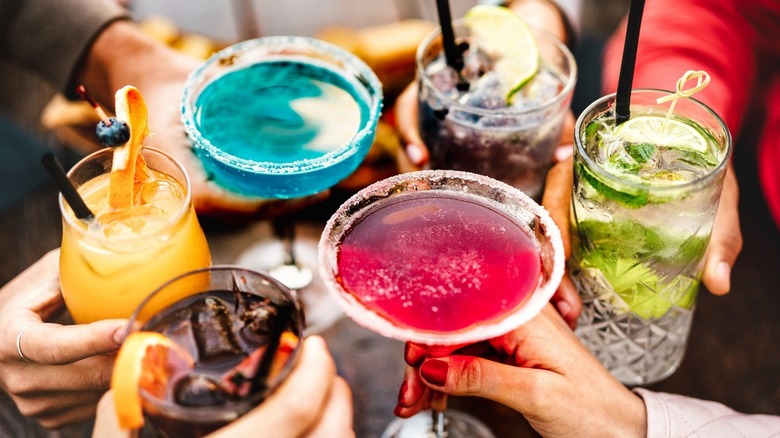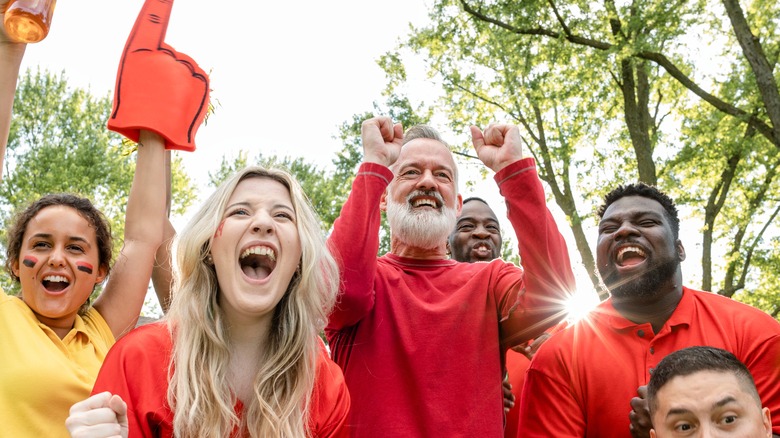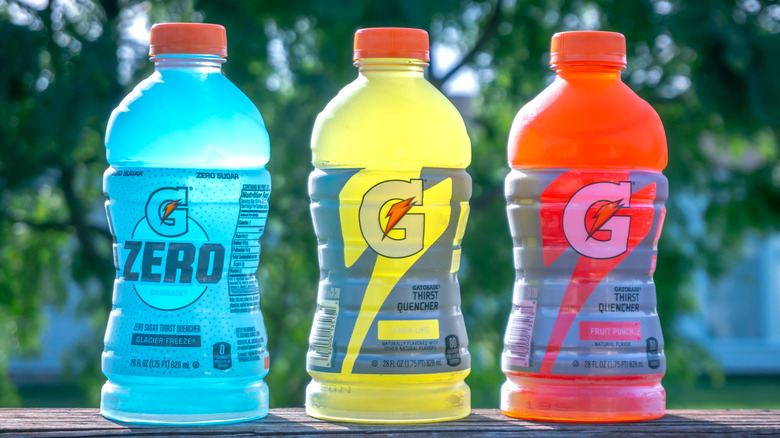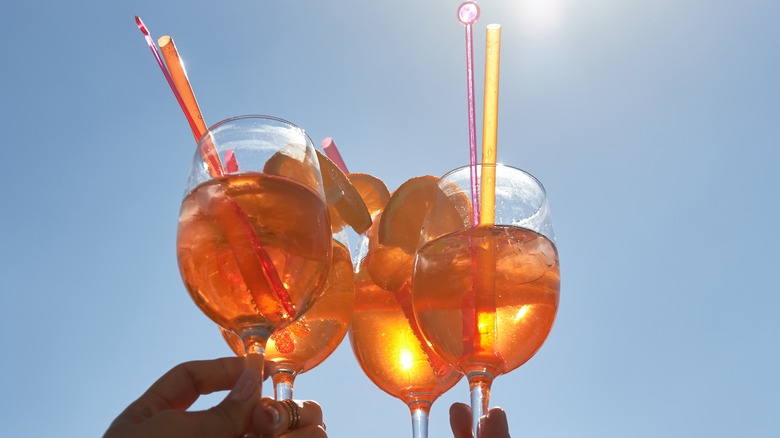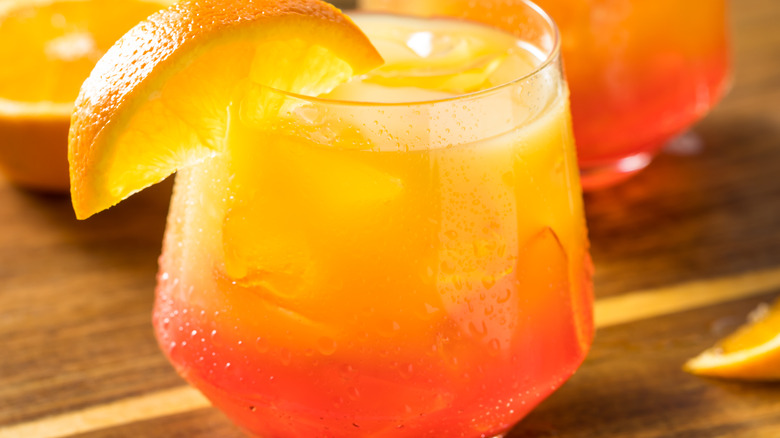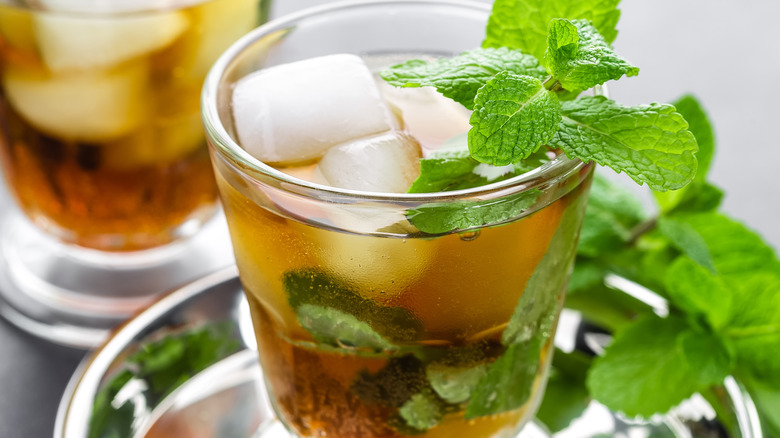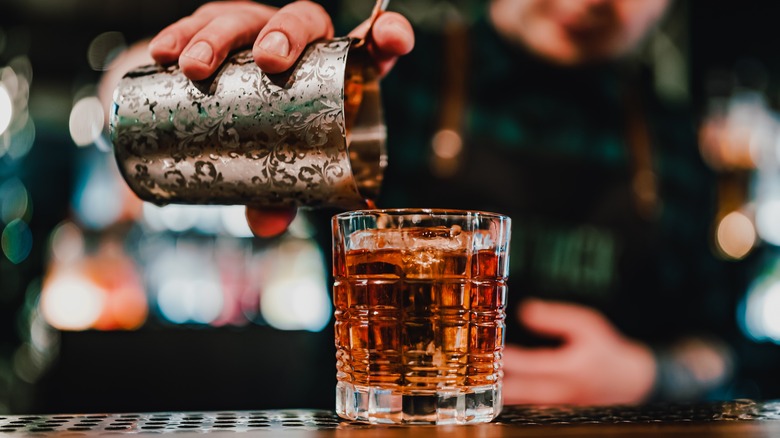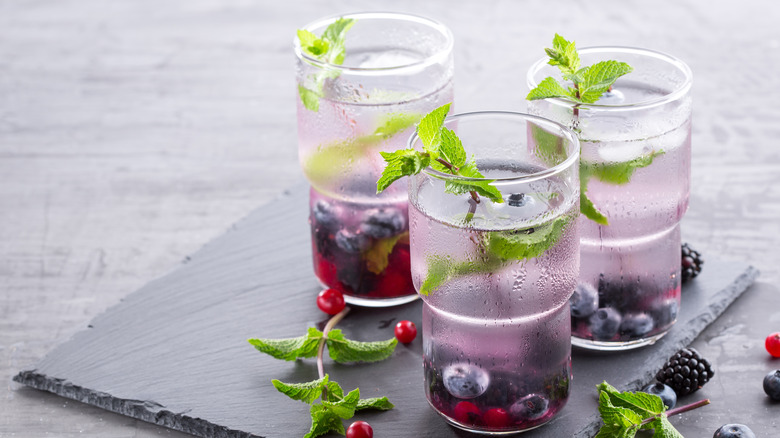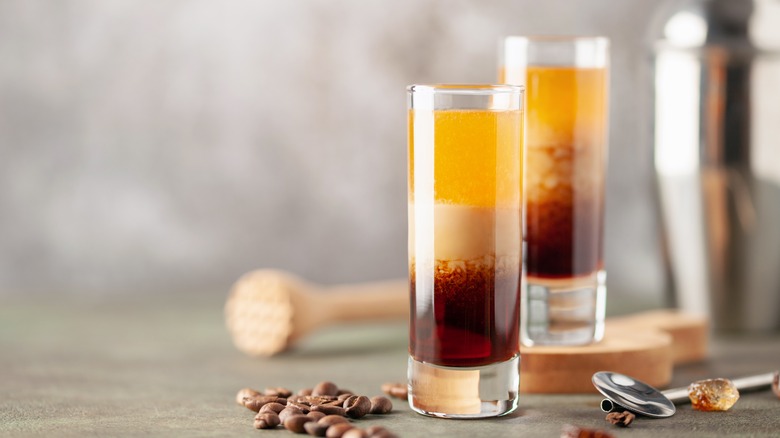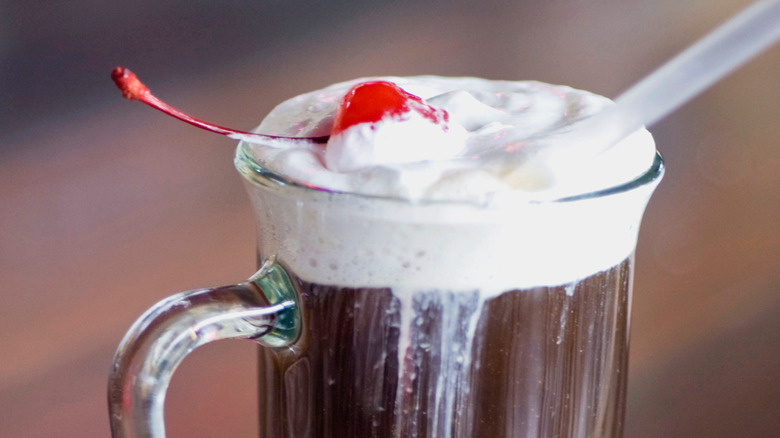The Colleges That Have Their Own Signature Cocktails
Many people's memories of college drinking include hazy recollections of cheap keg beer, jungle juice, and intense pregaming. College students are often strapped on cash and don't have the most discerning of palates. But there are more discriminating sorts out there, too. And not everyone is looking for quantity over quality (there's always Parents' Weekend, after all). When students graduate, older and much wiser (of course), they often start looking for something a little better: more worth their time, money, and tolerance, while still managing to fly their school colors. For college graduates, what could be better than a signature cocktail named after their alma mater?
A number of higher-education institutions have signature cocktails. Some hearken back to the first half of the 20th century and could be considered historic. Others have been invented more recently by tailgaters looking to produce a Pinterest-worthy tippler. Sometimes, traditional favorites have become emblematic of a particular university, while others are mired in mystery or — like the Vanderbilt cocktail — weren't actually named for the college, though die-hard college fans may not care (per Difford's Guide).
Despite the number of universities that have eponymous beverages, there are many more that don't. If your school's not on the list, don't worry — this may be the time to start a cocktail klatsch to see if you can come up with a beverage worthy of its institutional namesake.
Flying the colors
Many college cocktails were designed with the school colors in mind, often including a shade of blue. While many colleges acquired their official colors in the late 19th century (per Gentleman Joe), many cocktails are of more recent innovation, as food dyes and tailgating were less of a thing in the 19th and 20th centuries. But before moving on to these colorful concoctions, we should make note of a beverage that packs a punch. The Kansas City Ice Water is the cocktail of Columbia College in Missouri (per Advanced Mixology). It's a crystal-clear combination of gin, vodka, lime juice, triple sec, and lemon-lime soda. It looks like sparkling water, but it most certainly is not.
As for the blue cocktail crew, a number of universities include blue as one of their official colors. And some of those most likely to have inspired a signature beverage are those best represented in Bowl Championship series and NCAA playoffs. In that regard, the University of Michigan holds its own.
The Michigan Wolverinetini, like its name, is quite a mouthful. It gets a color boost from Blue Curaçao, and the addition of both pineapple juice and a pineapple slice (cut in the shape of an "M") lend a tropical flair to the northern clime tippler (per The Snappy Gourmet). The Michigan Big Blue Spritzer, meanwhile, features a shade of azure via the same Blue Curaçao but combines it with rum and Sprite for a sweet, bubbly beverage, notes Delish.
Blue, gold, and gator
Not to be outdone in the blue department is the UCLA Blue and Gold Punch (per Delish). This drink mixes it up by layering the drink: gold on bottom, with a stripe of blue on top. Tequila is the spirit of choice this time, and it's combined with pineapple juice for the base layer. Gatorade or another blue sports drink finishes it off with its distinctive coloring, providing a break from Blue Curaçao's intense blue sweetness.
While UCLA may be indifferent to the brand of sports drink incorporated into its cocktail, the University of Florida is most decidedly not. Gatorade was created at the college and the name itself pays homage to the school's mascot. So it's only natural that the university's signature drink should include Gatorade: the UF Gatorade Margarita, to be precise (per Advanced Mixology). Because Florida's colors are blue and orange, it's even possible to opt for an orange Gatorade instead of blue. (Either way, this sports drink variation is not recommended for athletes recovering from a game.)
Still, sports and energy drinks are natural mixers for those drinking on the sidelines. Michigan' State's Spartan Splash includes your choice of energy drink, grape vodka, and melon liqueur, according to The Food Channel.
Amber shades
While shades of blue hold a definite allure for tailgating purposes, warmer colors also get their due. Gold and yellow are important college colors — and they're easier to find in nature to boot. Both Highland College in Birmingham, AL, and the better-known University of Alabama love their Yellow Hammer-Slammers — despite the fact that neither's color is yellow (per Advanced Mixology and Garden & Gun).
The popular concoction includes vodka, rum, and amaretto, in addition to pineapple and oranges juices, so it's a pretty potent brew. This beverage has more backstory than most, too. Also known as the Alabama Slammer, the Yellow Hammer name comes from the state's official bird, and Galette's bar in Tuscaloosa (quite a local institution) has been serving the cocktail to happy alums since the '70s. Apparently, during some important football rivalry weekends, they serve up thousands to excited fans (per Williamson Source).
More recent inventions include the Clemson Tiger Paw, notes NorthJersey.com. Clemson's orange may be a fashion challenge, but it presents no problem for bartenders. The Tiger Paw features citrus vodka, lemon juice, a bit of sugar to offset the lemon's tartness, and orange soda for fizz and color. Rutgers' aptly named Scarlet Knight, on the other hand, is a minimalist's dream and testifies to the ease of creating a red cocktail. It's nothing more than Dubonnet and bitters, shaken and then served in a martini glass, a decidedly upscale presentation.
Classic and historic contenders
While many college cocktails are 21st-century creations, some date back further. One case in point is the Du Pont Hotel Cocktail, the signature drink of Delaware Technical Community College, which has a campus near the famous Wilmington hotel. The drink combines sherry, brandy, Angostura bitters, and an orange peel. The cocktail is simple, strong, and evocative of the Du Pont family's importance to the state and their hotel's vital role in Delawarian social life (per Food Schmooze). The drink was inaugurated in 1947 for a momentous New Year's Eve celebration and adopted by the nearby college (which also offers a degree in hospitality and hotel management).
The Du Ponts' hotel wasn't the only one developing swanky signature drinks; hotel bartenders have long been key players in the development of cocktails, according to Condé Nast Traveler. The tequila sunrise is considered the signature beverage of Northern Arizona and Prescott College (per Advanced Mixology and the Arizona Daily Sun) and was created by Gene Sulit of the Arizona Biltmore hotel.
The original version consisted of tequila, soda water, lime juice, and liqueur. But it made its way to Sausalito, California, where it was streamlined and colorized by mixologists Bobby Lozoff and Billy Rice at the Trident Hotel. The duo swapped out the original extras for grenadine and OJ. But Arizona natives remember its roots; the drink is so popular that it's spawned an annual drinking fest in Flagstaff bearing its name, starting as early as 6 a.m.
Classics brought to campus
Another hotel-created classic adopted by a college is the Bloody Mary, the signature drink of Northern Arkansas, according to Advanced Mixology. Invented by Fernand Petiot, it made its first appearance at the St. Regis Hotel's King Cole Bar in 1934. The Bloody Mary was often served as part of sumptuous, late-in-the-day breakfasts preferred by the hotel's patrons (per Town & Country). To avoid offending patrons, the hotel renamed its drink "The Red Snapper" — a name it retains at the St. Regis — but it's known by its spicier, original moniker everywhere else.
Kentucky State University's cocktail comes as no surprise to bourbon, bluegrass, and horse lovers, but its illustrious past may be news to some. The mint julep has its origins in minty, medicinal beverages served in the Middle East (julep comes from the Arabic word "julab," according to Food & Wine and Town & Country), which made their way around the world, both to Europe and the United States. It may well be the first American cocktail (per Food & Wine), and it's been a favorite of both politicians and novelists alike.
Still, the mint julep didn't become the official drink of the Kentucky Derby until 1938. But by then, it had been the clear favorite for a while. Given the strong identification of Kentucky with the Derby, it was a natural choice for Kentucky State — but we're not sure that the University of Kentucky couldn't lay equal claim to the refreshing sipper.
The Ivies' storied sippers
Not surprisingly, all of the Ivy League colleges have a signature cocktail, dating back to the first decade of the 20th century. But they're not all great drinks, as Slate reported after rigorous testing by a handful of connoisseurs over a very long lunch.
Though several of the Ivies have more than one signature cocktail, the core of these elite beverages skews traditional. Harvard's cocktail is basically an excellent riff on a Manhattan made with cognac, and Columbia's is similar, swapping dry vermouth for the sweet. Unsurprisingly, gin features prominently in the Ivy cocktails, in keeping with cocktail culture's resurgence during gin-heavy Prohibition (per Smithsonian). But other traditional spirits make their appearance as well: Princeton's cocktail adds port to its gin base, Cornell's includes Bénédictine, and the Harvard Cooler starts with Applejack or Calvados.
The Ivy League cocktails aren't all staid and predictable, however. Some of them are wearing fun socks and clever bowties. Take the Yale Cocktail, traditionally made with Crème Yvette, a violet-flavored, brilliantly-hued liqueur which tastes a bit like Grandma's perfume but is nicely offset by the orange bitters and dry vermouth. And then there's UPenn's Pennsylvanian, which Slate declared "not so much bad as weird" and is made with Calvados, Madeira, an egg white, and a lemon twist. Who says nerds don't have fun?
Local flavors
A significant number of college cocktails are connected to their local roots. They've adopted a drink that reflects regional favorites and flavors and taken it as their school's signature, often in a less formal way. Such is the case with several southern colleges. The LSU Spiked Blueberry Lemonade takes a classic summer drink perfect for LSU's sweltering climate, spikes it, and gives it a little purple and gold treatment with the addition of blueberries (per Always Order Dessert).
The Georgia Bulldogs Spiked Sweet Tea takes the ubiquitous southern beverage and gets the job done with the subtle addition of vodka, while Missouri's Old Missouri Spiked Root Beer is a much more intense flavor experience. (Spiced rum is added to root beer and garnished with whipped cream.) Wisconsin banks on its apple supply for its signature cocktail: The Angry Badger Spiked Cider takes regular old cider and jazzes it up with Fireball whiskey. If you're not sure why the badger is angry, you may understand once you've tried it; it's called Fireball for a reason.
The University of Texas likes to spice things up, too; the "Hook 'em horns" Margarita puts a jalapeño all up in the usual margarita business, for an extra kick. The drink is a relatively recent invention but is decidedly in keeping with UT's motto and the Mexican side of Texas' history (per Delish).
Mascots, mottos, and battle cries in a cup
The Auburn War Eagle Rum Punch takes the southern institution's battle cry and joins it with a crowd-pleasing cocktail that has no obvious connection to the college. It's nevertheless a delightful choice, especially in warmer weather; the punch combines rum with OJ and sprite for a refreshing choice that's likely to find fans, whatever side you're on (per College Weekends).
Another bird-inspired beverage is Oregon's Mighty Duck, a spiked lemonade with some soda water for bubbles. Some jazz it up by adding pear to it; pears are Oregon's state fruit, according to Piedmont Grocery. Continuing up and around the coast, there are more ducks, but they're not as subtle. University of Alaska's signature beverage is a layered shot called a Duck Fart and includes Kahlua, Baileys, and Whiskey (traditionally, Crown Royal) — in that order, so that each spirit holds its own. While the college connection may be somewhat new, the Duck Fart has a well-established place in the Alaskan repertoire (per Mantitlement) and in the hearts of late-night revelers.
You might expect Notre Dame's pugnacious spirit to come out in its cocktail, but they've hedged their bets. True to form, South Bend's famous university embraces more than one alcoholic drink, leaving the fighting to those on the field. The Fighting Irish Return to Glory features ginger ale, peach Schnapps, orange juice, and whiskey in a tall glass (per Intoxicology); the "Luck of the Irish" is a Jameson-spiked lemonade (per Delish).
Cold-weather options and future inspo
The Ohio State Redeye, also a newcomer on the cocktail scene, packs a wallop, per Cocktail Builder. Like the Long Island Iced Tea, it's a more-is-more sort of beverage that combines vodka, gin, triple sec, peach and blackberry liqueurs with orange and pineapple juices, topped with Sprite. But even heavy-drinking Ohio fans are no fools; they know how cold outside games can get, and the Ohio State's Boozy Buckeye combines everyone's favorite warming beverage — hot chocolate — with Bailey's or bourbon and hot chocolate, for a rich beverage that will help keep the chill away while watching your favorite team (per The Spiffy Cookie).
Hot or cold, blue, yellow, red, or green ... there are dozens of college cocktails out there just waiting for an excuse (and a willing mixologist) to make them. Perfect for tailgates, homecoming weekends, and alumni get-togethers, signature beverages help weave a college's story, and provide more fodder for future tales.
And if history is any judge, universities that don't have signature beverages — yet — are simply leaving the path open for creative minds to connect their college traditions with something worth sipping.
